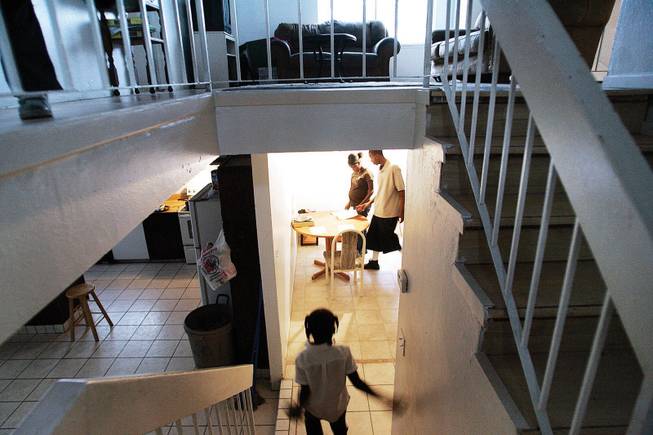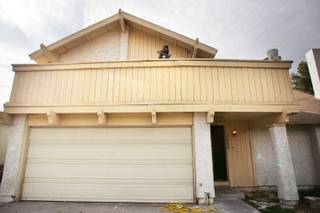
Shea Hampton-Earl and her children lived in two public housing projects in Las Vegas before moving into this home using a Section 8 voucher.
Monday, Nov. 16, 2009 | 2 a.m.
Sun Archives
- Demise of Vegas public housing ‘projects’ sought (7-1-2008)
- Subsidized apartments could change hands (5-28-2008)
- His dream: A Las Vegas without public housing (3-25-2008)
- Closing means fewer homes for poor (5-29-2007)
Beyond the Sun
Beyond the Sun
Shea Hampton-Earl’s living room is empty, but her head is full of ideas.
This spring, she will plant a garden with tomatoes and collard greens in the back yard of the house she just moved into. And in a few years, the 36-year-old mother of seven wants to buy the house with its path that leads to a park in the back and a tree-lined street in the front.
Only two months ago, Hampton-Earl’s front door opened onto the pop of pistols and the hum of police helicopters overhead. There were no gardens, no parks.
Hampton-Earl’s family lived in one of the 250 apartments at Ernie Cragin Terraces, a public housing complex scheduled to be turned into dust early next year.
The single mother and her children are living through the biggest change in Las Vegas Valley public housing since the 1940s.
During the next five to 10 years, the newly-formed Southern Nevada Housing Authority plans to reduce about 850 public housing apartments to rubble, changing the lives of thousands of people. The complex plan includes replacing those apartments with mixed-income, low-density houses. Some public housing tenants will move into those houses. Many others, like Hampton-Earl, will use the federal Section 8 voucher program to rent wherever landlords accept the vouchers. And a minority — up to 30 percent in other places where public housing has been demolished — will not be eligible for vouchers. They will have to move into what little public housing remains in the valley or find places on their own.
It is too early to know how the plan is working out, but as families like Hampton-Earl’s move on, it is the beginning of the end of public housing as we know it, at least for “the projects” the Las Vegas Housing Authority managed for decades.
The Las Vegas agency was the largest of the region’s three agencies until it was folded into one this year. For now there are no plans to demolish the public housing formerly under the other two, North Las Vegas and Clark County.
But controversy has followed similar plans elsewhere since the first one unfolded in Atlanta 13 years ago, followed by Washington, D.C., New Orleans and Baltimore. To date, nearly 100,000 public housing apartments have been scheduled for demolition. And despite protests, the federal Housing and Urban Development Department backs the idea, seeing it as a way to remove people from the poverty that builds up in public housing.
The opposition has been based on the idea that tearing down the buildings breaks up communities and can lead to homelessness. Initial research in Atlanta suggests that most people have used Section 8 vouchers to move so close to the torn-down projects that they wound up staying in poverty. Also, according to Erin Ruel, a Georgia State University researcher following the Atlanta experience, demolishing public housing may lead to a net loss of affordable housing.
There are no comparable studies planned yet for the Las Vegas Valley, but Carl Rowe, interim executive director of the Southern Nevada Housing Authority, says he is optimistic about the plan, noting that 137 families have found places to live with vouchers.
Hampton-Earl beams while describing her current situation, with “nothing pulling me in the wrong direction.” The tall and wiry former Wal-Mart manager sits on one of the few pieces of furniture in her new house, contrasting her recent past with the future she wants.
She grew up on family-owned land in Mississippi and later, in Detroit, never depending on government programs for housing. But when she broke off her relationship with the father of her children three years ago, she found that her $11-an-hour job wasn’t enough to cover all the bills, so she sought help. She wound up first at Sherman Gardens, another public housing project slated for demolition, and then Ernie Cragin.
“This was our first time living like this,” Hampton-Earl says. By ‘this,’ she means seeing teenagers sporting gang colors and police officers daily outside her door, not to mention shootouts. One of her sons, then 13, “got into it with bad kids.” He was arrested for burglary after breaking into a school. Her son is now on probation, in a court-ordered plan made while they still lived in the projects that includes staying with his father. She hopes to have him back with her in January, in the new house, where she thinks all of them “have a better chance at growing.”
About 15 miles north of Hampton-Earl’s house near Tropicana Avenue and McLeod Drive, Larry Garrett is still unpacking after his Sept. 1 move to a house near Cheyenne Avenue and Pecos Road.
Garrett is a rare single father to come out of public housing. Like Hampton-Earl, he sees his new house as a new start.
Garrett slid into public housing shortly after his now 7-year-old son developed nephrotic syndrome, a condition that leads to swelling all over the body. Garrett, who works laying carpets and tile, had to take care of his son nearly full-time for about four years. They moved into Ernie Cragin in 2002, where the rent was free.
He learned about Section 8 from working on houses rented out voucher holders. Now he lives in one of those houses, which he hopes to fix up and eventually own.
At Ernie Cragin, Garrett wouldn’t let his son and now 10-year-old daughter out of the house unless he could watch them. Now neighborhood children come in the house after school, drop off their backpacks and run back out to play.
“It’s a huge difference,” he says. “There was no community feeling there (at Ernie Cragin) ... Everyone was out for themselves, with bad language, chips on their shoulders, gang colors.”
Hampton-Earl and Garrett both pin their hopes in part on a housing authority program called Family Self-Sufficiency. It pairs caseworkers with voucher holders, drawing up five-year plans to get better jobs, repair credit and learn about buying a house. The idea is to break free of government assistance.
Deidre Oakley, who is working with Ruel on the $146,000 grant to study the effect of the Atlanta experience on hundreds of former public housing tenants, says such programs can play a vital role in achieving the best outcome from tearing down public housing — not just dispersing poverty, but helping families overcome it.
But such programs are chronically underfunded, and often poorly run, she says. Rowe, of the Southern Nevada Housing Authority, says there are 352 people on the self-sufficiency program waiting list.
Rowe also points out that not everyone is cut out for such programs. More broadly, he says, not everyone will see moving out of “the projects” as a step up and some may not change their lives at all.
Garrett thinks of the lack of motivation he saw in some young men he offered part-time work at Ernie Cragin, and wonders if they won’t wind up in the same lifestyle somewhere else, or even wind up in the same neighborhood. “It really depends on the family whether or not this move is a good thing,” he says. “I can’t see a lot of people from there living in houses and acting as if they can do whatever they want all the time, because they can’t.”
Rowe has been working with some families to develop what he calls “soft skills,” which include such simple things as housekeeping, reading leases and handling such bills as utilities, often not a part of life in public housing.
Also, he notes, “even though a family has a voucher that allows them to move into a an upper- or middle-class neighborhood, they don’t always do so for various reasons, not the least of which is they don’t feel comfortable.”
To date he has seen no evidence of large numbers of former public housing tenants staying in the neighborhood surrounding Ernie Cragin, which stretched out in the area where Bonanza Road meets 28th Street.
“We know they’re not concentrating in any one area,” he says. “But we know little else.”
The sea change coming over public housing in the Las Vegas Valley is only in its first wave, but it will most likely avoid one problem seen elsewhere — the disproportionate effect on senior citizens. In Atlanta, for example, Oakley says there has been a “clear demarcation” along age lines when it comes to the demolition of public housing and subsequent relocation of tenants. “Younger people saw it as an opportunity, older people were less enthusiastic,” she says. Older, low-income people tend to rely on nearby friends and family for help with everything from shopping to doctor appointments and breaking such ties can be a setback.
But the valley’s 800-plus public housing apartments for senior citizens formerly under the Las Vegas Housing Authority will remain untouched, Rowe says.
He also has an answer for those who criticize the demolition of public housing and increased use of Section 8 vouchers because it results in a loss of brick-and-mortar, affordable housing. First, Rowe says, up to 20 percent of the mixed-income housing that will rise from the rubble is going to be set aside for low-income families. And second, the valley has an abundance of housing available for voucher-holders. In fact, “there is some evidence that the economy has helped” by increasing the number of houses that owners are seeking to rent out. The agency’s list of landlords willing to take vouchers has increased by about 10 percent in the past year, Rowe says.
In the years to come, the valley will become another laboratory for answering the decades-old question of how to fight poverty, particularly when it comes to the most basic of needs, housing.
It will be compelling if more families wind up like Garrett’s, or Hampton-Earl’s.
“I see myself having a bright future,” Hampton-Earl says, talking of her plan to go to Le Cordon Bleu College of Culinary Arts so she can someday open a restaurant. She owes that optimism to her new house, where she says she sleeps easier and worries less.
“Here, you can look out your window and have something to smile about ... It’s like someone’s giving me a chance.”


Join the Discussion:
Check this out for a full explanation of our conversion to the LiveFyre commenting system and instructions on how to sign up for an account.
Full comments policy